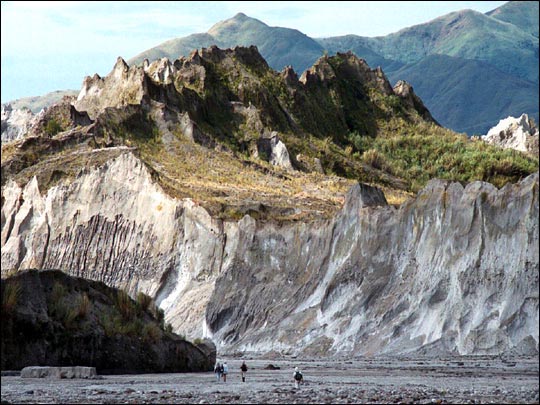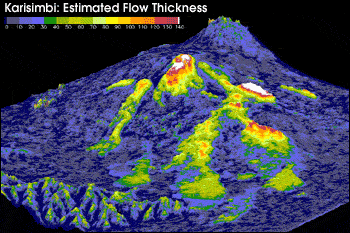

The Essential Role of Ground Surveys |
|||
A critical part of demonstrating that a mapping instrument in orbit or in the air has accurately seen what’s on the surface is to directly compare the remote data with measurements made on the ground. In November 1999 Mouginis-Mark led a group of University of Hawaii scientists on an expedition to Mt. Pinatubo to map some of the steep valleys cut into lahar deposits and the broad sediment outflows spread across the landscape. |
|||
 | |||
On their way by helicopter from Clark Air Base to begin their expedition on the west flank of the volcano, the scientists flew over the Pasig-Potrero River and the summit of Mt. Pinatubo. Mouginis-Mark remembers seeing "complex networks of deep, deep canyons cut into the lahar. This type of very steep erosion is unique to lahars. This must have been what the mythical Greek labyrinth looked like." Later as the team hiked over the lahar-covered landscape, they visited a village partially buried by lahar deposits. Mouginis-Mark recalls stepping directly into the second story of a centuries-old church half buried by lahar deposits that the villagers were excavating. The team surveyed the dimensions of several "erosional valleys" using a laser range finder. The valleys are a few kilometers long, from 50-80 meters wide, and 30-50 meters deep. These precise measurements will be compared with SRTM digital maps to see how well SRTM can see into these valleys, which have nearly vertical walls. Mouginis-Mark expects to begin this work this summer when he receives his first batch of SRTM Mt. Pinatubo data. "We don’t have a complete digital topographic data set for the volcano," says Mouginis-Mark. "SRTM is our mission of choice for a data set that will give us a quantum step forward in our knowledge of the erosion of the volcano." He will also use extensive field measurements and TOPSAR data of Hawaiian volcanoes to validate the accuracy of the SRTM maps. Then it will be on to studying other tropical volcanoes with SRTM maps, in
particular volcanoes in Java and other parts of Indonesia. "Many of these
volcanoes won’t be studied on the ground due to personal safety concerns
related to the local political situation. Our Mt. Pinatubo work will give us a
good calibration point that we can use to evaluate how effective the SRTM data
are in studying volcanoes in tropical environments." The other advantage of
remote-sensing observations of volcanoes, says Mouginis-Mark, is that it allows
volcanologists to study whole volcanic regions, not just one volcano at a time,
which has been the traditional focus of earthbound scientists. |
Scientists from the Philippines and the University of Hawaii hike across an "erosional valley" toward the nearly vertical edge of a massive 1991 lahar deposit over 60 meters high. The team measured the dimensions of these valleys to find out how well these features can be seen by instruments in space. (Photo by Peter Mouginis-Mark) | ||
 One limitation of radar mapping systems flown to date is that they do not penetrate thick forest cover very well. The radar data from the airborne TOPSAR, for example, only slightly pierces the forest canopy. Most of the signal bounces off of the dense tree tops before reaching the ground. Consequently, the maps made over heavily forested areas "see" the surface somewhere between the top of the trees and the surface. The upcoming launch of another NASA mission will help fix this limitation. The Vegetation Canopy Lidar (VCL) spacecraft, a joint project with the University of Maryland, will simultaneously measure where the tops of trees are and where the ground is using lidar, a radar-like instrument that uses a laser beam. Mouginis-Mark plans to use VCL data to subtract out the forests from the SRTM data to generate a "bald Earth" topographic map of volcanoes that pose significant local hazards.
|
By comparing digital topographic maps made before and after an eruption, scientists can precisely measure the amount of material produced by a volcano. This technique, used here to calculate the thickness of lava flows on Karisimbi volcano in Zaire, will be used on Mt. Pinatubo to calculate how much volcanic debris has been carried off the volcano by lahars. (Image courtesy Mary MacKay and Harold Garbeil, University of Hawaii at Manoa) | ||